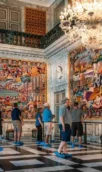Copenhagen Opera House – Architecture and History
Copenhagen Opera House – Architecture and History. The Copenhagen Opera House is among some of the most modern Opera Houses in the world. It’s beautiful to look at and very well equipped, but what about the history of it? In this blog post, we explain the whole story behind this majestic building. Enjoy!
History
The whole project was a donation by the A.P. Møller and Chastine Mc-Kinney Møller Foundation to the Danish state. The politicians of Denmark questioned the donation since the whole project would be tax deductible. In 2000, the project got a green light and construction began in the year 2001.
With the construction of the opera house completed in October 2004, the inauguration took place in January 2005. The Copenhagen Opera House is one of the worlds most modern, and well-equipped, opera houses in the world. It’s also among the most expensive opera houses with construction costs exceeding US$500 million.
The location of the opera house is directly opposite the main castle in Copenhagen, Amalienborg, across the water. This means that people outside the opera house are able to look across the water, through the garden and castle of Amalienborg all the way to Frederik’s Church, the Marble Church, and vice versa.
Architecture and Layout
The architect of the Copenhagen Opera House, Henning Larsen, worked together with Mærsk Mc-Kinney Møller, which proved to be problematic. Mærsk had requests that would not practically work. The building seems to be on an island, due to the canals surrounding it. Oak trees planted in the early 19th century, originally purposed to recover the Danish fleet after the bombardment of Copenhagen in 1807, were used for the bridges that lead to the opera house, thus honoring the marine history of its location.
The first design of the building had large glass panels all over the front with the goal of displaying the shell of the auditorium even from the outside. The design was changed to a metal grid with smaller glass panels by Mærsk who thought that the large glass panels wouldn’t age well.
The foyer floor is covered with Sicilian Perlatino marble and the central foyer is further decorated with three large chandeliers designed by Icelandic artist Olafur Eliasson. The logotype for the opera house, designed by Per Arnoldi, is visible on the marble floor, just inside the entrance, and four other logo’s where created in bronze by Per Kirkeby and placed on the walls in the auditorium. Per Arnoldi also designed the front curtain for the mainstage with a three-dimensional look made from multiple color threads.
Treated maple decorates the rear wall of the foyer and balcony faces with the intention of looking like wood from an old violin. About 105 000 pure carat (100%) gold leaves are covering the ceiling in the auditorium.
Facts
- Rooms: 1000+
- Area: 41 000 m²
- Floors: 14, 5 of which are located underground.
- Stages: Mainstage + 5 stages directly connected.
- Seats: 1703 to 1492, dependant on the size of the orchestra.
- Architects & Engineers: Henning Larsen (A), Ramboll & Buro Happold (E) with A.P Møller as the executive.
- Acoustics: Arup Acoustics
- Lighting: Speirs and Major Associates
- Orchestral pit: One of the largest in the world. 110 rooms with excellent soundproofing for the musicians.
- Cost: US$500 000 000+

